If you’re a service business looking to boost efficiency and profitability, this guide is for you. Whether you run a small IT support company or a large HVAC enterprise, keep reading to find the best field service management software for you.
Managing a service business is a high-stakes balancing act with zero margin for error. A missed step, such as failing to dispatch technicians on time, could ruin the company’s reputation and impact the bottom line. This is why you need field service management software to automate your operations.
Field service management (FSM) software streamlines scheduling, dispatching, job tracking, time tracking, and other processes. It eliminates scheduling conflicts, missed appointments, and other chaos that cost you money and customers.
However, finding the right field service management software can be overwhelming with the myriad options. I tested numerous FSM software and refined your options to the top five:
- Connecteam
- UpKeep
- Synchroteam
- Fieldmotion
- OptimoRoute
In this guide, I’ll reveal the strengths and weaknesses of each solution. Read on to find your best fit.
Our Top Picks
-
1
Best for all-in-one field service management and team coordination
-
2

Good for maintenance and asset management
-
3
Good for scheduling and dispatching field teams
Why trust us?
Our team of unbiased software reviewers follows strict editorial guidelines, and our methodology is clear and open to everyone.
See our complete methodology
How I Chose the Best Field Service Management Software
I tested various software, evaluating the key factors like ease of use, features, and cost to pick the top five FSM solutions. Since these solutions are built for field teams, I took them out in the field to determine how features like location tracking work. Some of the features I considered include:
Important Core Features
- Scheduling and dispatching: This helps assign the right technicians to the right job at the right time, optimizing efficiency. The best FSM software supports automatic scheduling, letting you dispatch field workers based on their availability, skill set, and location.
- GPS location tracking: Real-time GPS location tracking helps you assign jobs to the nearest technician, improving response times and fuel efficiency. You can also look up a technician’s location to give customers accurate ETAs.
- Time tracking: The best FSM solutions allow you to track time accurately for proper billing, fair remuneration, and detailed productivity insights. It also prevents time theft, allowing you to compensate each technician for actual hours worked.
- Inventory management: The software should also track equipment, parts, and tools in real-time, preventing costly delays and shortages.
I also made sure the software is:
- User-friendly: Easy-to-use FSM software enables dispatchers to assign service requests effortlessly. It enables technicians to quickly access checklists, customer history, and job details without fumbling around.
- Mobile-friendly: The software should also offer Android and iOS apps. Mobile apps enable technicians to view schedules, track inventory, and update job statuses anytime, anywhere.
Finally, I checked for features that make field service management software great:
- Reporting and analytics: A great FSM software provides detailed reports to help you track performance, improve efficiency, and enhance decision-making.
- Billing and invoicing: An FSM software with built-in billing and invoicing tools speeds up payments, improving your cash flow.
- Customer management: Customers are the backbone of your service business. The best software enables you to manage them well to boost satisfaction and loyalty.
The 5 Best Field Service Management Softwares of 2025
-
Connecteam — Best for all-in-one field service management and team coordination
Connecteam is an all-in-one field service management software that helps service businesses manage and optimize field service operations. It’s widely used in industries like HVAC, IT support, plumbing, electrical services, and maintenance.
Why I chose Connecteam: I chose Connecteam because of its feature-richness, ease of use, and affordability. I was particularly impressed by the software’s auto-scheduling, time tracking, and real-time location tracking capabilities. Not to mention the job tracking feature, which helps ensure no service request slips through the cracks.
Let’s take a closer look at Connecteam’s main features and benefits:
Automatic scheduling and dispatching
With Connecteam’s auto-scheduler, you no longer have to search for an available technician. When a service request comes in, simply create an open shift and define requirements, like required skills. Once you click the magic icon, Connecteam auto-assigns the job to the right technician in seconds, saving you the manual hassle.
I also appreciate that the auto-scheduler assigns jobs based on technicians qualifications to boost service quality. For example, you can set the qualifications for a commercial HVAC repair job so that it’s not assigned to a junior technician. This prevents misdiagnosed problems and incorrect repairs that often lead to wasted resources and costly revisits.
Connecteam also supports automatic shift swaps, letting technicians find replacements on their own. If a manager’s approval isn’t required, the app re-assigns the shift automatically to prevent service disruption. During shift swaps, scheduling rules — like technicians qualification — apply to maintain consistency and quality of service.
Another feature I liked was Connecteam’s recurring shifts, which helps schedule planned or routine maintenance tasks. You can schedule regular HVAC system tune-ups, fire safety equipment inspections, or plumbing inspections. The app supports daily, weekly, and monthly recurring frequencies, making it easy to schedule any recurring contracts.
Forms and checklists
If you’re worried about technicians missing critical steps, use Connecteam’s Checklist feature. A checklist helps you provide technicians with step-by-step repair and service procedures.
For example, you can use them to outline the steps technicians should take for every HVAC maintenance visit. Doing so ensures technicians follow a consistent process across all visits, improving service quality.
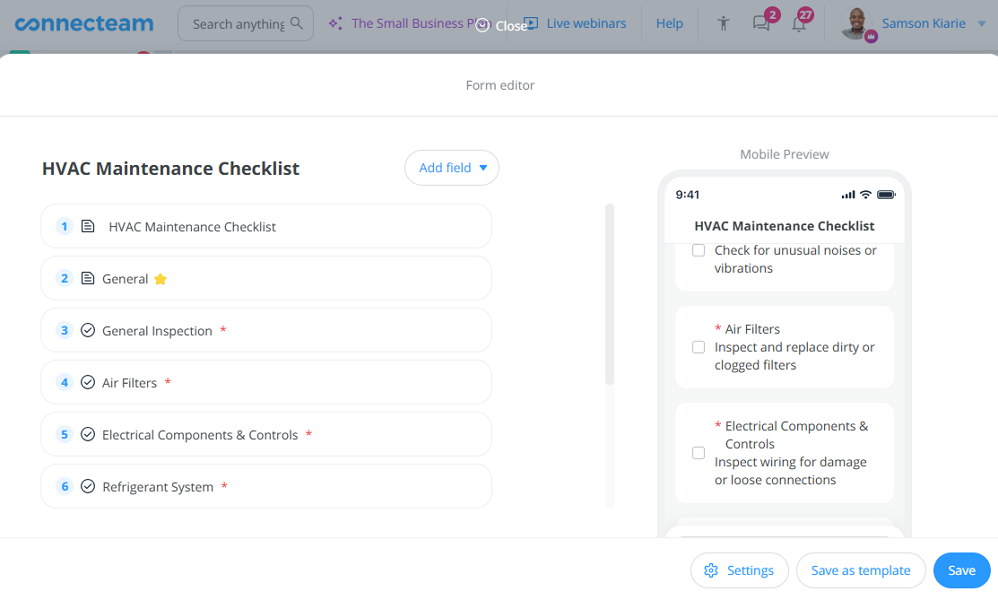
Moreover, you can have a pre-visit checklist to ensure technicians bring the right tools and parts.
One thing I liked is that the checklists are editable. This allows you to tweak your procedures for increased operational efficiency and to accommodate new industry regulations.
Connecteam can also capture the technician’s location when they input the response to a checklist item. This helps verify whether the technician was actually within the customer’s location when they completed the checklist.
Accurate time tracking
If you pay technicians by the hour, Connecteam’s time tracker ensures fair and accurate pay. With timely clock in/out reminders, technicians won’t forget to log their work hours. The automatic clock-out and clock-in restrictions help reduce timetheft, potentially saving your business thousands of dollars.
I also liked Connecteam’s overtime tracker, which lets you track various types of overtime. Besides streamlining compliance with labor laws, it enables you to compensate employees fairly for their effort. The cherry on top is that Connecteam computes overtime pay automatically, saving you hours of manual calculations.
If you want to restrict overtime to control labor costs, you have two options. First, configure Connecteam to alert you when technicians exceed their daily or weekly limit. Second, you can set Connecteam to automatically clock out employees when they hit the overtime threshold.
Connecteam’s break tracker enhances compliance while ensuring technicians are well-rested. I liked the option to restrict employees from returning early from breaks. It ensures technicians take the mandated break length for full compliance. Plus, using the forms and digital signature features, you can create a break attestation to further enforce break compliance.
Real-time location tracking
With Connecteam’s GPS location tracker, you no longer have to worry about whether technicians are where they need to be. Simply open the map to monitor technicians’ real-time location.
Real-time location tracking is helpful for proximity-based dispatching. It helps dispatchers assign urgent jobs to the nearest technician. This improves response time, ensuring employees resolve issues before they escalate. Moreover, assigning jobs based on a technician’s location can significantly reduce travel costs, boosting your profitability.
Additionally, Connecteam’s advanced breadcrumb feature makes it easy to monitor a technician’s route. All you need to do is open the map and click the “route” icon corresponding to the tech name. You’ll see the technician’s route with an animated arrow indicating the direction. You can also click the white dots (breadcrumbs) to see when a tech was at a location.
Pricing
Free-for-life plan availablePremium plans start at $29/month for 30 users
14-day free trial, no credit card required
Start your free trial -

UpKeep — Good for maintenance and asset management
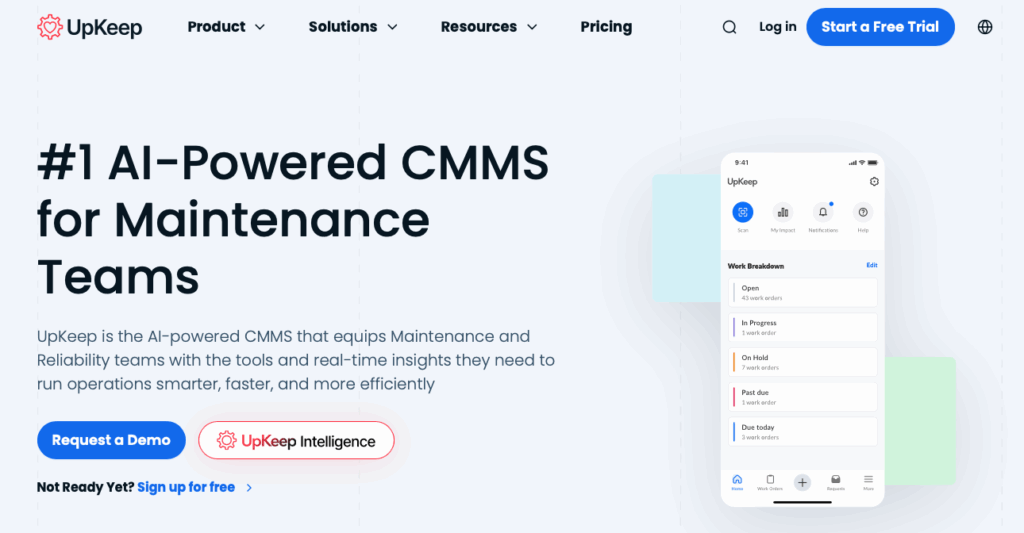
UpKeep is a mobile-first computerized maintenance management system (CMMS) for maintenance and reliability teams. It’s ideal for businesses in various industries, including healthcare, energy & utilities, manufacturing, and maintenance.
Why I chose UpKeep: I chose UpKeep because of its mobile-first approach. It enables technicians to access work orders, log maintenance records, and update task statuses. As a result, your technicians don’t have to complete a batch of paperwork or wait until they are back at the office to log important details.
However, UpKeep doesn’t offer a time tracking feature, which can be off-putting for businesses that pay technicians by the hour. Let’s discuss some of UpKeep’s main features:
Work order management
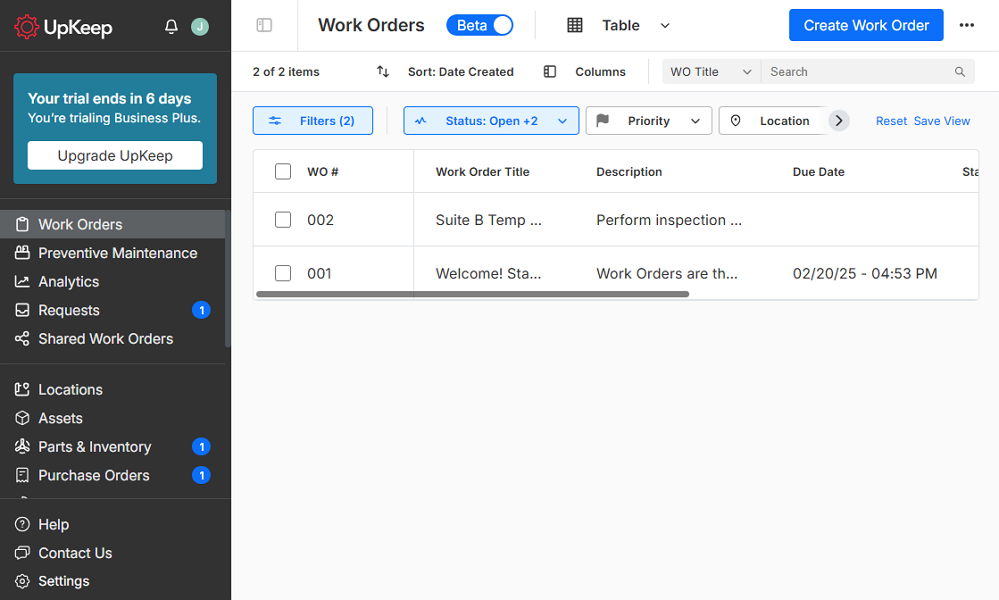
Creating a work order with UpKeep is a breeze. UpKeep’s work order management feature allows you to create, assign, and track maintenance jobs in real time.
What I really liked is that each work order has the details a technician needs to complete the job. You can attach photos, checklists, and comments so the tech knows what is expected with each maintenance job. This reduces missed service steps to boost first-fix rates and improve customer satisfaction.
Setting task priority to either high, medium or low is also helpful. Priorities enable technicians to focus on critical tasks while handling low-priority jobs within the agreed timeframe. Doing so improves efficiency for field service teams, ensuring no customer issue goes unaddressed.
Schedule preventive maintenance triggers
I also appreciate the preventive maintenance (PM) feature, which helps you schedule routine maintenance. You can create a work order outlining the task’s nature, location, and assignees and then set it to repeat based on usage metrics or time intervals, which is impressive.
Take, for example, a manufacturing company that needs to keep its industrial air compressors in perfect condition. Using the PM triggers, UpKeep will send technicians timely maintenance reminders based on usage hours. This prompts technicians to check for wear and tear, change oil, clean filters, and lubricate the machine in time, reducing the risk of breakdowns.
UpKeep lets you add the location and asset to each preventive maintenance order. You also have the checklist and a history of previous maintenance in the work order. With these details, a new tech can take over from where a colleague left off and still deliver quality work.
What users say about UpKeep
UpKeep has an overall rating of 4.6 out of 5 stars across more than 1345 reviews on Capterra. I also scoured other review sites and found numerous positive reviews, including:
Keeps the work orders organized. Keep the Maintenance team on top of where they are in the process.
However, it’s not all roses. Some users have gripes with UpKeep, though it seems most of them aren’t related to the core function. One user claims:
The parts I use most often are those with the lowest part number, so I need to reorder the sequence the moment I look at them.
Key Features
- Work requests with the ability to attach pictures
- Inventory management
- Digital checklists and forms
- Maintenance calendar
Pros
- Excellent customer support
- Efficient work order management
Pricing
Starts at $20 per month per user Trial: Yes — 7 days Free Plan: No
-
Synchroteam — Good for scheduling and dispatching field teams
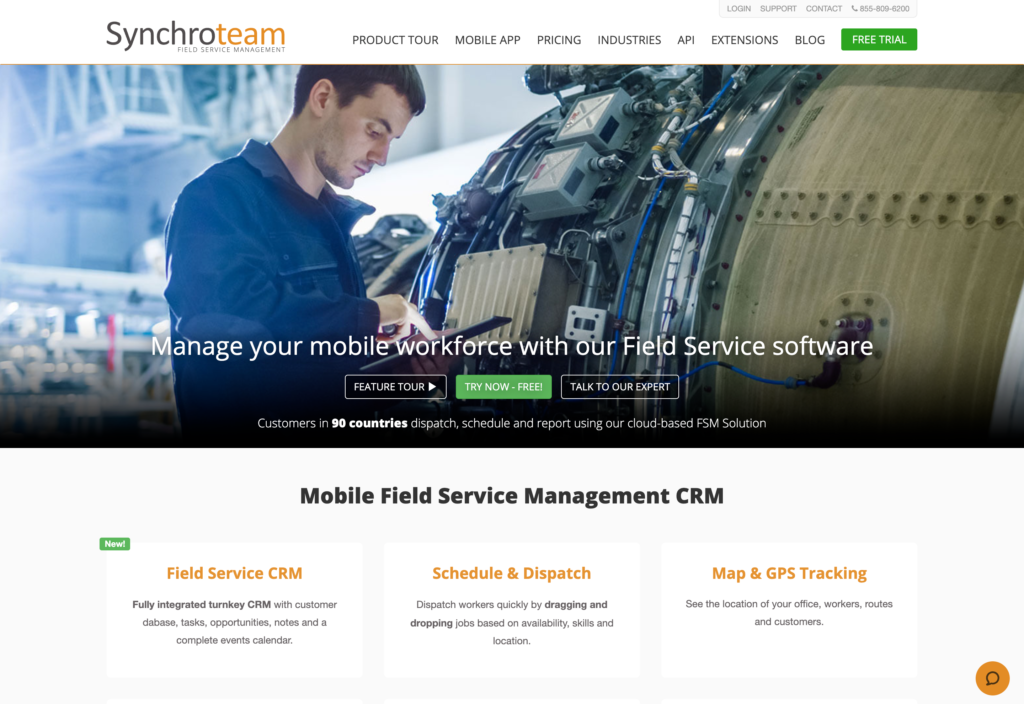
Synchroteam is a field service management software designed to help businesses simplify processes and optimize costs. It’s ideal for businesses in the maintenance, telecoms, security, HVAC, energy, and medical industries.
Why I chose Synchroteam: I chose Synchroteam because of its suite of field service management tools, particularly the route optimization feature. It also offers time tracking, job management, customer management, and GPS tracking tools. Let’s explore some of its main features:
Scheduling and dispatching
The first thing I noticed was that Synchroteam prioritizes functionality over aesthetics. Its scheduling and dispatching grid looks old-fashioned and might confuse dispatchers accustomed to modern solutions. That foible aside, the software offers an easy-to-use drag-and-drop tool to simplify scheduling.
My favorite Synchroteam feature is ScheduleAssist, which helps find the best available technician for a job. It considers factors like skills required for the job, technician availability, and distance from the job address.
Considering these factors eliminates scheduling conflicts and optimizes task distribution. It also ensures jobs are assigned to the nearest technician, improving response times and reducing travel time, saving fuel costs. Moreover, assigning field technicians to jobs that match their expertise enhances service quality.
That said, I found it difficult to configure ScheduleAssist, and it might not be a playground for total beginners. Additionally, the feature offers limited customization options and isn’t suitable for field service businesses that are handling highly complex scheduling scenarios.
Route optimization
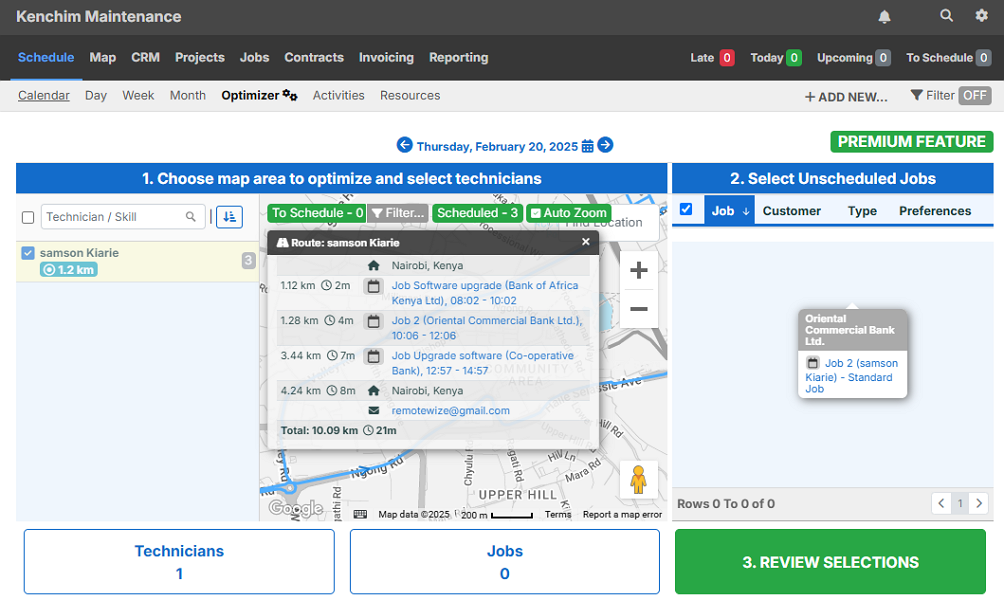
Synchroteam shows distance and driving time between locations. I appreciate Synchroteam’s route optimizer, which helps automatically plan the most efficient service routes. Using the optimizer is a breeze — simply open the tool, select technicians and assigned jobs, and follow along with the wizard.
Synchroteam analyzes job priorities and location data to generate an optimal route. Keep in mind that the “optimal route” doesn’t always mean the shortest route. Sometimes, the app organizes the job order to enable the technician to tackle urgent issues first. Technicians can view their optimized routes via Synchroteam’s mobile app.
However, I found some minor drawbacks with the optimizer. For example, once you create a route, you can’t edit it manually to adopt last-minute routing preferences. An option to manually drag-and-drop jobs to reorganize the route would be a welcome boost.
What users say about Synchroteam
Synchroteam has garnered an overall rating of 4.5 out of 5 stars after 90 reviews on Capterra. The overwhelming majority of the reviews are positive.
I would totally recommend it to anyone in industry that needs schedule coordination, time tracking, mapping services, contract management, job reporting, and more!
While most users seem impressed by the web app, a majority have issues with the mobile apps. I scrolled through the reviews on Google Play, and many users claim that Synchroteam’s Android app is bug-laden:
Crashes when trying to close Job and sent email to tech support 4 times in a week and no response or resolution.
Key Features
- Scheduling and dispatch
- GPS tracking
- Job management
- Route optimization
Pros
- Easy-to-use route optimizer
- Efficient ScheduleAssistant
Cons
- ScheduleAssistant is difficult to set up
- The Android app is bug-laden
Pricing
Starts at $31.5/user/month Trial: Yes — 14 days Free Plan: No
-

Fieldmotion — Good for automating field service workflows
Available on
- Web
- iOS
- Android
- Windows
- Mac
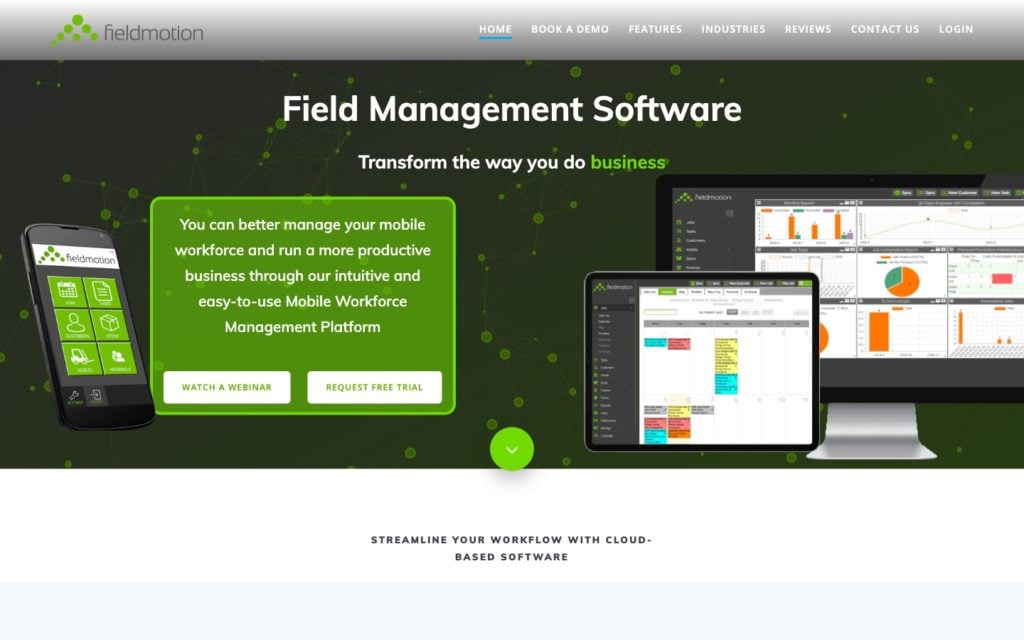
Fieldmotion is a job management platform designed to help service businesses streamline field operations. It’s ideal for HVAC, electrical services, plumbing, and other field and maintenance businesses.
Why I chose Fieldmotion: I chose Fieldmotion because of its job management capabilities. Using a combination of job scheduling, automated reminders, and team communication, the software streamlines recurring contract jobs and planned maintenance. However, Fieldmotion lacks vital tools like time and location tracking. Let’s dive in:
Job scheduling
Unlike Connecteam or Synchroteam, Fieldmotion doesn’t have an automatic scheduler. Still, I found it easy to schedule jobs and dispatch technicians on the web or mobile app. The app lets you switch between different scheduling views — a list, calendar, map, and timeline — whichever suits your preferences. The map view shows you where jobs are based on the client’s address.
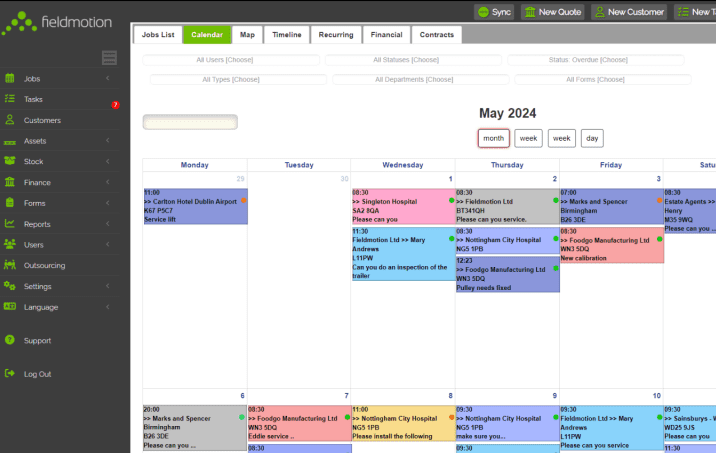
Fieldmotion lets you create color-coded shifts. The drag-and-drop scheduler enables you to schedule jobs and balance workloads with ease. You can schedule one-off or recurring jobs. The latter fits the bill for recurring contracts and planned maintenance tasks. It enables you to create a job and set it to repeat on a custom frequency. This saves you the hassle of having to schedule the job repeatedly.
When you schedule or update a job, Fieldmotion notifies technicians instantly. This keeps techs on top of their schedules and job requirements, preventing missed visits. While the feature works as expected, it could be better. For example, an option to let field technicians swap shifts would significantly improve its effectiveness.
Job workflow
Another feature I liked was Fieldmotion’s job workflow, which automates operations, minimizing manual work. Just bear in mind that this isn’t the typical task workflow, where you track progress through phases. Instead, the Fieldmotion workflow eliminates manual paper work.
It enables field electricians, plumbers, and engineers to complete forms on their smartphones. Automated workflow eliminates manual data entry, ensuring seamless job documentation. The forms can include multiple-choice questions, dropdown options, photos, and signatures. This makes it ideal for job status updates and job reporting.
You can configure Fieldmotion to trigger email notifications when field technicians complete a job. It also notifies the inventory manager when stock levels are running low, so they can order supplies on time. This ensures field technicians always have the necessary resources to complete jobs. Ultimately, this eliminates delays, boosting efficiency and job completion rates.
However, creating a custom job workflow can be an intricate process. You may have to request Fieldmotion to customize the forms to suit your specific workflows.
What users say about Fieldmotion
Like Synchroteam, Fieldmotion doesn’t have many reviews online. On Capterra, the software has an overall rating of 4.7 out of 5 stars after 38 reviews, which is good. There are no reviews on Google Play Store, which is oddly surprising. Here’s one of the positive comments I came across:
Excellent piece of software, which the Fieldmotion team were able to tweak to meet our exact needs
Some users online lament Fieldmotion’s inability to integrate with their go-to software. Others complain that it takes time to complete the job form.
The integration with Xero is terrible; it creates a new customer for each of there sites.
Key Features
- Job scheduling
- Purchase order
- Job management
- Customer management
Pros
- Easy to schedule planned maintenance
- Efficient job workflow
Cons
- Limited integrations
- No automatic scheduler
Pricing
Starts at £30/per license Trial: No Free Plan: No
-

OptimoRoute — Good for route planning and optimization
Available on
- Web
- iOS
- Android
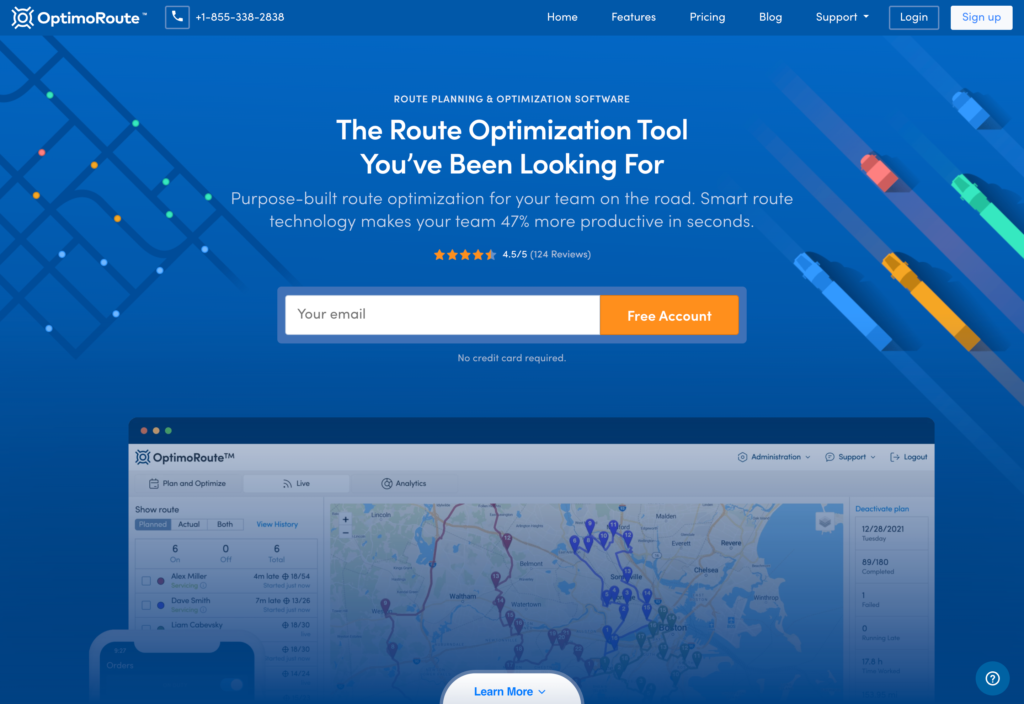
OptimoRoute is a route planning software for businesses looking to optimize routes for mobile teams. Its functionalities make it a reliable solution for HVAC, plumbing, electrical services, and other field service businesses.
Why I chose OptimoRoute: I chose OptimoRoute because of its superb route optimization and planning capabilities. Rather than packing in tons of field service management features, the provider focuses on route planning — and nails it. It’s unsurprising then that it’s one of the best app for ensuring on-time deliveries and optimizing technicians’ routes. Let’s dive in:
Route optimization and planning
To plan or optimize a route, you need to first create or import orders, which I found to be a breeze. The orders can be a list of customer addresses or locations where your delivery driver needs to drop off parts and materials.
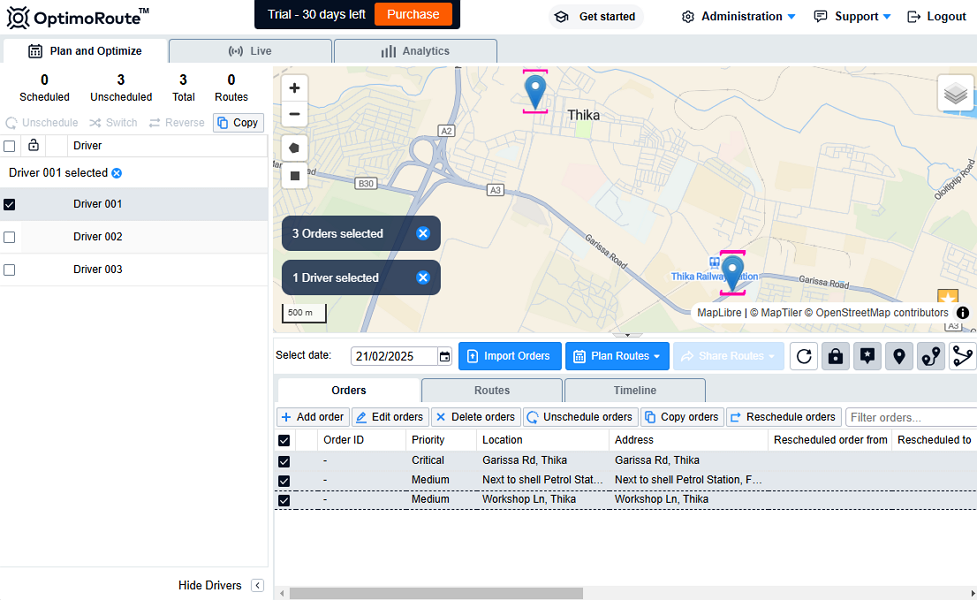
OptimoRoute routes ensures technicians handle urgent requests first What I liked is that OptimoRoute lets you define the customer service or stop duration per location. Most importantly, you can set the priority for each order. For example, you can set emergency jobs to have critical priority while others have medium or low priority.
Once you import the orders (jobs) and technician, click “plan routes” to generate an optimal route. I was impressed by the route optimizer capabilities. It takes into account a technician’s location and job priorities to create an optimal route. During my testing, OptimoRoute created the shortest route that ensured I handled high-priority jobs first.
You also get a host of options to share the route with technicians. You can email the route directly to the technician or download to GPS in Garmin, TomTom, or Navigon format. The best option is to send the route directly to the technician’s mobile app.
Live tracking and ETA
OptimoRoute enables you to monitor field activities in real time from the comfort of your office. When you open the “live” tab, you get a map and table view to help you monitor technicians. In the table, you can see when each service was scheduled to start, when it actually started, and when it was completed.
If there was a delay, OptimoRoute marks it in orange in the respective column. If a technician completes a job early, the app marks it in green. In both cases, OptimoRoute gives you the exact number of minutes of delay or running early. This information helps you plan a technician’s next move.
What I really love is that OptimoRoute gives you an accurate ETA for the next job as long as technicians regularly mark job status. Even if they don’t, the app recalculates the next job’s start time based on driving speeds and GPS location, giving you real-time updates. No more guessing when a technician will arrive for a repair job.
What users say about OptimoRoute
If the reviews online offer anything to go by, it’s that OptimalRoute is a reliable route-planning software. On Capterra, the software has garnered an overall 4.6 score out of 5 stars after 188 reviews, which is impressive. One business owner asserts:
Optimoroute makes it extremely easy to create the weekly routes.
There are a few complaints, here and there. One issue I found was with the software’s reporting and analytics features. One user opines:
I want better analytics. I need to be able to break down our performance by location. I need more elaborate reporting.
Key Features
- Route planning
- Field service scheduling
- Live-tracking
- Proof of delivery
Pros
- Efficient route planning
- Accurate live tracking
Cons
- Lacks vital field service management features
- No free plan
Pricing
Starts at 17.50/driver/month Trial: Yes — 30-day Free Plan: No
Compare the Best Field Service Management Softwares
| Topic |
 Start for free
Start for free
|

|
|

|

|
|---|---|---|---|---|---|
| Reviews |
4.8
|
4.6
|
4.5
|
4.8
|
4.5
|
| Pricing |
Starts at just $29/month for the first 30 users
|
Starts at $20 per month per user
|
Starts at $31.5/user/month
|
Starts at £30/per license
|
Starts at 17.50/driver/month
|
| Free Trial |
yes
14-day
|
yes
7 days
|
yes
14 days
|
no
|
yes
30-day
|
| Free Plan |
yes
Free Up to 10 users
|
no
|
no
|
no
|
no
|
| Use cases |
Best for all-in-one field service management and team coordination
|
Good for maintenance and asset management
|
Good for scheduling and dispatching field teams
|
Good for automating field service workflows
|
Good for route planning and optimization
|
| Available on |
Web, iOS, Android, Windows, Mac
|
Web, iOS, Android
|
What Is Field Service Software?
Field service management software is a digital tool that helps businesses manage their field service teams and operations. It automates critical tasks like scheduling, dispatching, work order management, and invoicing. Doing so improves the efficiency and effectiveness of field service teams, enhancing productivity, service quality, and customer satisfaction.
How Does Field Service Management Software Work?
While not all field service management software are built the same, the core principles of how they work are the same. The solution enables you to create employee schedules and assign tasks based on the team’s availability, qualifications, and location. It also helps you handle last-minute changes and unexpected service requests.
Once the field employees are out in the field, the software lets you monitor their activities. The best field service management software, like Connecteam, shows you technicians’ real-time location. They also let you monitor the status of all of your work orders, view logged data, and work order history.
Additionally, field service management software helps monitor technician attendance. It also enables you to track time for fair remuneration and compliance. The best solutions pack tools such as geofencing, facial recognition, and automated clock-outs to enhance timecard accuracy. They also include overtime and break trackers to streamline compliance with labor laws.
What Are The Benefits of Field Service Management Software?
The main benefits of using field service management software for small businesses include that it helps:
- Boost efficiency by streamlining and automating daily processes, such as scheduling, dispatching, helpdesk ticketing and work order management.
- Enhance visibility and control by providing real-time visibility into employee performance, job status, and inventory levels, allowing you to make data-driven decisions and identify areas for improvement.
- Improve customer satisfaction by allowing you to quickly handle service orders, assign jobs, and provide employees with real-time access to relevant job information to provide faster and more personalized service.
- Increase revenue by allowing service contractors to bill customers more accurately and quickly, reducing the time and effort required for invoicing.
- Ensure safety and compliance by enabling you and your team to be in constant contact, instantly communicate issues, and stay up-to-date on proper work procedures.
How Much Does Field Service Software Cost?
The pricing of service management software vastly differs per provider — it can range from $75-$2,000 per month. Your subscription costs depend on the number of users and the feature package. The provider can adopt a flat-rate or user-based pricing model. The latter can get rather expensive if you’re working with a large team.
Thankfully, you’ll find reliable FSM tools with affordable flat-rate pricing. My number one pick, Connecteam, charges $29 per month for 30 employees. This works out to less than $1 per month per employee, which is impressive. Even better, Connecteam has a free plan for small businesses with up to 10 employees.
FAQs
Yes, field service management software can help you schedule shifts fast and from any location. Applications such as Connecteam are available for both desktop and mobile and allow you to schedule from any location.
Yes, with Connecteam, scheduling shifts is fast, and since the field software management is available on both mobile and desktop, you can schedule from any location. The great thing is that you can copy and paste shifts from Yes, reporting is a crucial part of your line of work and therefore most of the field service management software will offer you a detailed reporting system. These reports can be filled out directly from the field so that managers are updated with the data they need to pass on to their customers in real-time.
If you are currently calling or texting, it can take hours to keep up with your employees. Field service management software such as Connecteam speeds up and simplifies cross-employee and field-to-office communication for example with an internal field ticketing software.
Pick a Reliable Field Service Management Software
Ideally, the solution of your choice should offer vital features at an affordable price. Make sure the software has scheduling, dispatching, location tracking, time tracking, and inventory management. It should also offer a user-friendly mobile app.
If you’re still undecided, I recommend using Connecteam. This all-in-one field service management software ticks all the right boxes for small and large enterprises.





